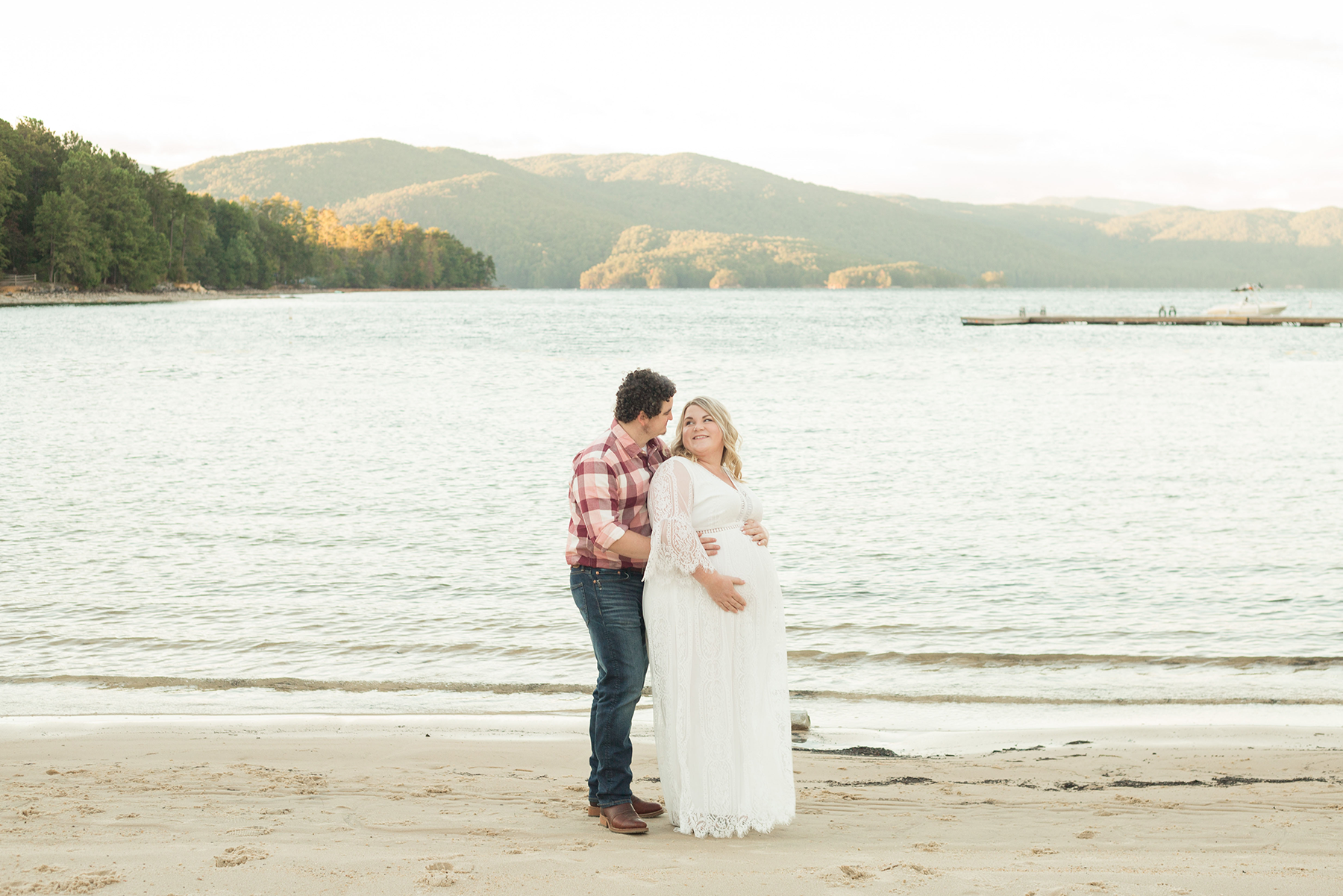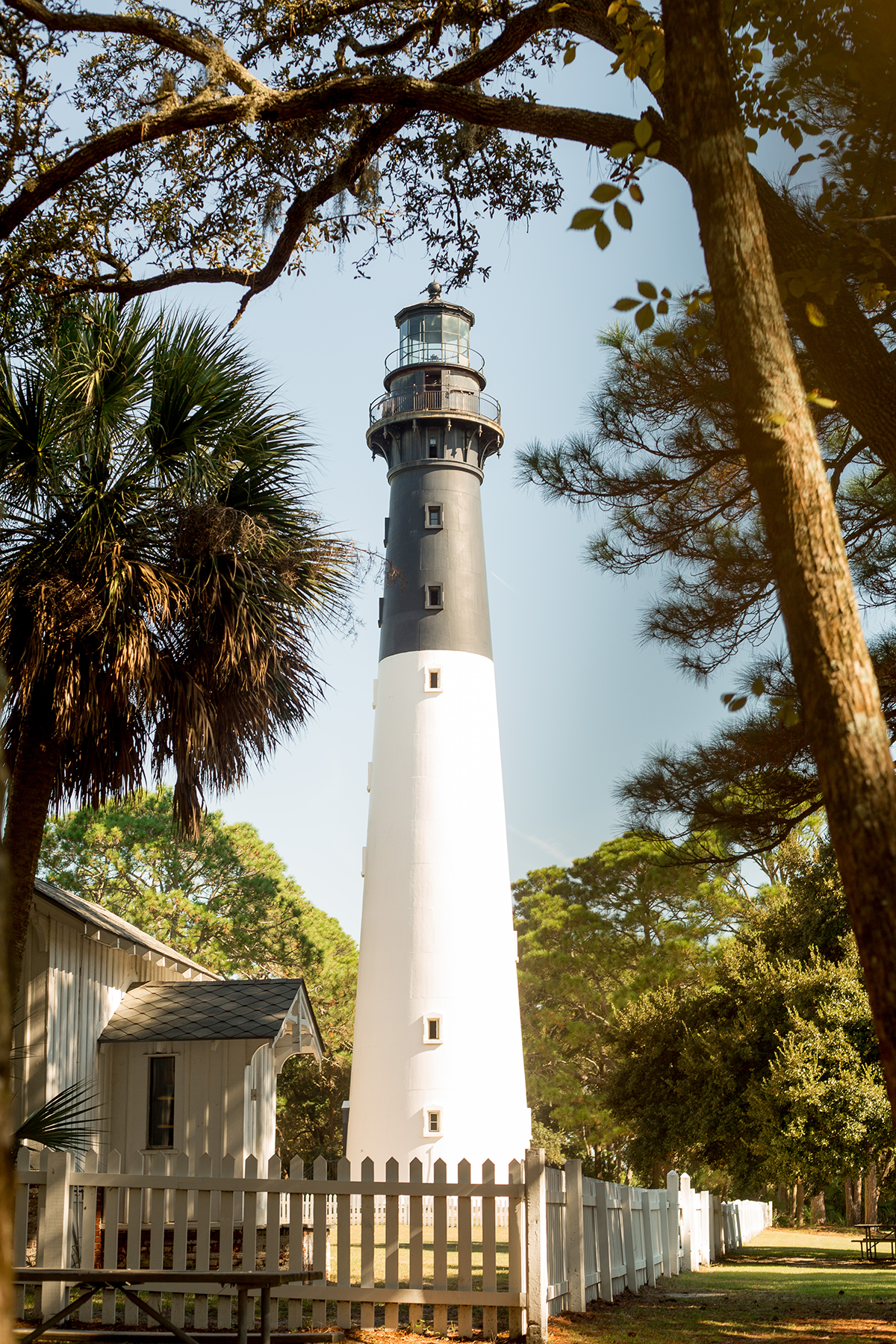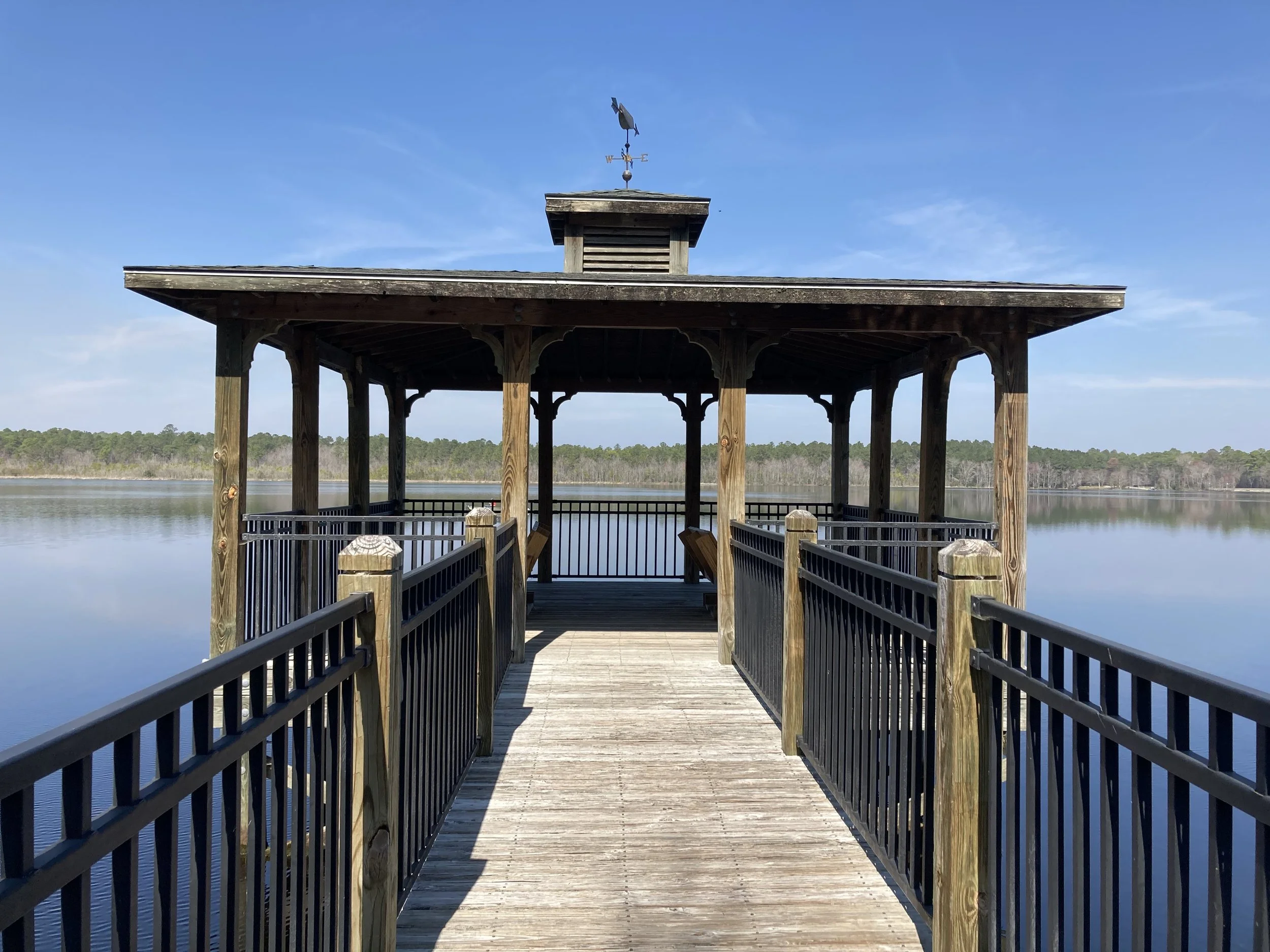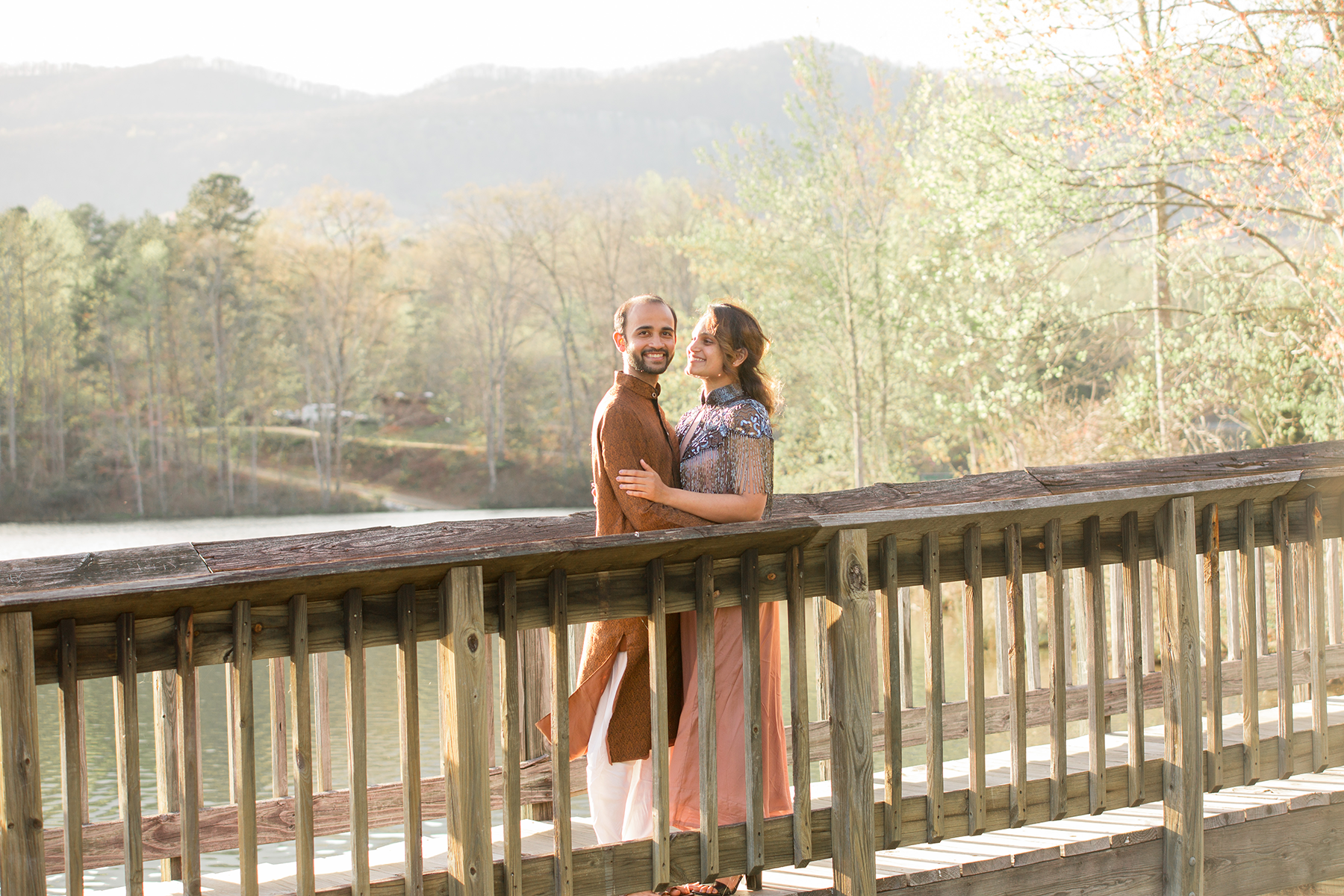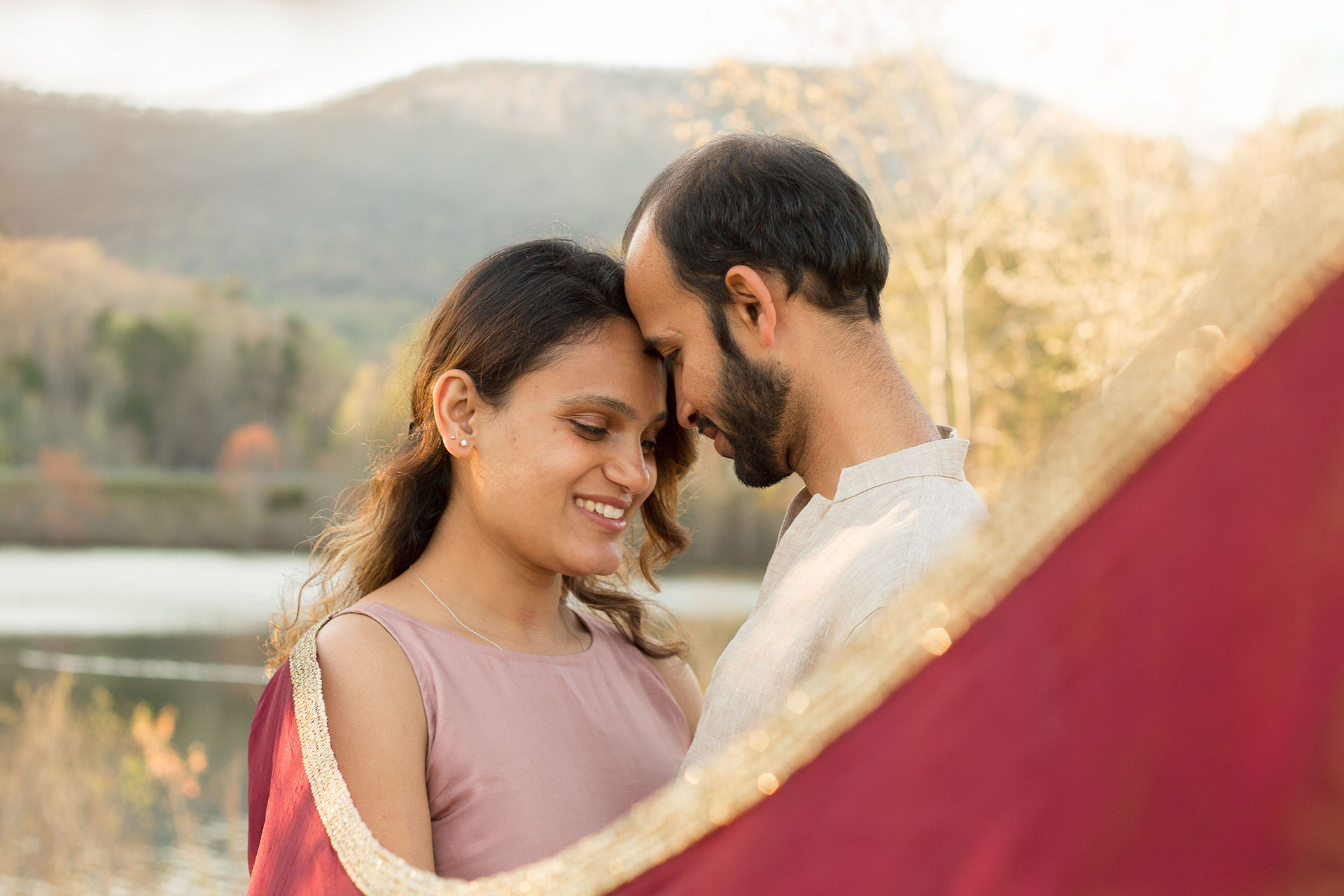In April 2022, my husband (Dan), my beagle (Athena), and I became Ultimate Outsiders. That means we’ve visited all 48 South Carolina State Parks! This process was an amazing experience where we got to visit every corner of the state, learn about the culture and history in different parts of the state, and see some beautiful places. Not to mention the memories we made along the way! I hope this post helps you choose a park to visit, and answers the questions you may have about becoming an Ultimate Outsider yourself.
What is the South Carolina Ultimate Outsider program?
If you visit all 48 state parks in South Carolina, you will receive a certificate and a t-shirt. You will also be part of a mailing list for events that are only for Ultimate Outsiders, like picnics, tours, and an online scavenger hunt.
What do I need to become an Ultimate Outsider?
The only thing you truly need is a state park guidebook. Each park has its own page with a spot to get a unique stamp. This is what you will need to show the park rangers for them to verify that you’ve visited every park. Click here to purchase your guidebook online, or pick one up for free at a state park office.
Something that’s not mandatory, but I HIGHLY recommend, is buying an annual state park pass. This is $99 and covers the admission for anyone in your vehicle at all state parks for a year. Although not every park has a fee, the fees can be up to $12 per person to enter a park. This can quickly add up to more than the $99 you’ll pay for the annual pass, especially if there are multiple people in your car and you’re trying to visit a lot of parks in a year. This pass also gets you into some of the buildings and events, such as Atalaya Castle and the Hunting Island Lighthouse. Click here to purchase an annual pass, or buy one from any state park office.
Something you can do for fun is complete the South Carolina State Parks scavenger hunt with the GooseChase app. There are different items on the list that will require you to either tag your location or submit a photo. For example, you can tag your location when you’re standing on a bridge that the challenge describes, or you can submit a photo you took of a spoonbill and put the name of the park in the caption. Once you’ve become an Ultimate Outsider, you’ll be invited to another scavenger hunt, which may include more than just what’s in the state parks, and you can win prizes.
What do you do at the state parks?
It depends on the parks! Some parks mostly serve as an access point to a lake, where you can boat, fish, or swim. Others have historical places you can learn about, hiking trails, and natural landmarks. Some host events, like guided hikes or festivals. 38 of the parks in the system are considered state parks, 8 are considered state historic sites, 1 is considered a state recreation area, and 1 is considered a state resort. For navigating through this post, you can search for words like “trail” in your browser and it’ll bring you to where I’ve mentioned hiking.
What’s your favorite state park?
I don’t really have one, but I liked the ones in the mountains and at the beaches the best. The ones that come to mind as my favorites are Table Rock, Caesars Head, Devils Fork, and Hunting Island. After we got all the stamps, we made note of which parks we wanted to revisit and what time of year would be best to revisit them.
How did you choose which park would be the last stamp?
As we crossed some parks off the list, we realized that some of the smaller parks don’t always have a ranger in the park office, so we needed to choose a more popular park to guarantee a ranger would be there to check our book. We looked at the parks we had left and determined we would end at Sesqui. This was partly because it’s pretty popular, so we’d be more likely to find a ranger to check our stamps, and partly because we thought it’d be cool to end in the state capital.
How did you visit them all?
We’re lucky to live in Greenville County, where lots of parks are within an hour and a half of our house. Some of the parks were their own day trip, like if we were doing a hike, but there were other times where we visited multiple in a day. For example, we easily visited Oconee, Oconee Station, Devils Fork, and Keowee-Toxaway in one day to get a stamp for each, but we’ve also made separate day trips for each of them. We had a few camping trips where we would camp at one park and visit others that were nearby. We stayed the night with a friend for a weekend trip where we visited five parks.
Can you stay overnight at the parks?
Most of the parks have overnight accommodations. Some have drive-up campsites for your car or RV, some have hike-in campsites, and some have cabins. Hickory Knob is a resort with indoor accommodations and dining services. We chose some of the less popular parks for camping so we could have a quieter place to sleep and we could get to know those less-visited parks better. The less popular ones also tend to have lower fees for camping and more availability. For example, when we got a beachfront campsite at Hunting Island, it was more than twice the cost of a campsite at Givhans Ferry, with only a few sites available on the weekend we were looking at. Each park will have their overnight options listed on their page, if they offer them.
Are all the parks dog-friendly?
Each park allows dogs in outdoor areas, as long as they’re leashed and not disrupting people/wildlife, but might exclude them from certain places, like the Animal House at Charles Towne Landing. Dan and I took turns with things like touring Atalaya Castle while the other stayed behind with Athena. I did get stressed out over having her in some of the places where alligators hang out though.
Can you get married at the state parks?
Some of the state parks have actual wedding venues: Table Rock has the Gaines Lodge, Huntington Beach has Atalaya Castle, and Charles Towne Landing has the Legare-Waring House and Founder’s Hall. Others have pavilions and amphitheaters you can ask about using. If you’re eloping, you have a little more freedom with where to have a ceremony with a pretty view because you’re not having a huge gathering of people that would disrupt other visitors, so you’ll want to call the park office for the park you’re thinking about to see what their policies are. You can read more here about how to elope in South Carolina, and I have some suggestions here for where to do it!
I’m scared of alligators and bears. How do I avoid them?
I’ve never actually seen bears in South Carolina, but I know they tend to be in the mountains. You may see warning signs for alligators at pretty much any park that’s south or east of Columbia, but they tend to not come out in the colder months. If you’re in a place where there may be gators and you don’t want to see one, try to stay away from fresh water, including boardwalks over marshes. At Hunting Island, we were told that the gators tended to be further inland, away from the ocean. I stumbled upon one in the tall grass by the observation deck at Huntington Beach.
Are there national parks in South Carolina?
South Carolina is home to Congaree National Park, a cypress swamp east of Columbia. There are also several other places in the national park system:
National Historic Sites: Charles Pinckney, Ninety-Six
National Historic Park: Fort Sumter and Fort Moultrie, Reconstruction Era
National Military Park: Kings Mountain
National Battlefield: Cowpens
National Historic Trail: Overmountain Victory (NC, SC, TN, VA)
And now, here’s a list of all 48 South Carolina State Parks and our experiences with them!
Sunrise at Hunting Island State Park
The Parks
(in alphabetical order with a few notes about our experience)
Aiken State Park (Windsor/Aiken County): There are 4 lakes at this park, which are along the blackwater Edisto River, so it’s great for anything water related. There is a kayak trail here, and some artesian wells with really good-tasting water.
Andrew Jackson State Park (Lancaster/York County): Andrew Jackson was born in a village that is now considered to be on the border between North and South Carolina. It’s unknown where exactly he was born in that village, but he verbally told someone he was born in South Carolina, so South Carolina claims him as the only president to be born here. This has some cool buildings to explore, like an old schoolhouse. There is a dog statue here, and seeing other dogs arrive one by one to bark at it was pretty funny. Athena didn’t seem to mind it though.
Baker Creek State Park (McCormick/McCormick County): This is one of three parks on Lake Thurmond, which is about 71,000 acres, so it’s a good place to take a boat. The other two parks on Lake Thurmond, Hamilton Branch and Hickory Knob, are a short drive away. There are mountain bike trails and campsites here. It has a big pavilion that overlooks the lake.
Barnwell State Park (Blackville/Barnwell County): This is a small park in a rural area that’s mostly used for fishing. There are three small ponds here and I thought the white bridge was really pretty. They hosted a movie night here over the summer. Alligators and wild turkeys are no strangers to this park. The Healing Spring is nearby, where you can fill containers of water that’s said to have healing powers.
Battle of Musgrove Mill State Historic Site (Clinton/Laurens County): This is the site of a Revolutionary War battle between Patriots, Loyalists, and British soldiers. There are a couple trails here that lead you to small waterfalls, and it has some notable trees.
Battle of Rivers Bridge State Historic Site (Ehrnhardt/Bamberg County): This historic site has an interpretive trail through a Civil War battlefield. This is part of an area with a lot of preserved Civil War history—we drove past a MASSIVE re-enactment site on the way here, with a cavalry, tents, and everything! We loved walking through the Spanish moss along the Salkehatchie River and Three Mile Creek.
Caesars Head State Park (Cleveland/Greenville County): Although the area near the visitor center seems small, this is actually the largest state park in South Carolina. The overlook is the highest point in any South Carolina park, and there are two trails that lead to the largest waterfall in South Carolina (Raven Cliff Falls). The overlook is easily accessible from the parking lot and you can easily see Table Rock, as well as some of the other mountains in the area. This is one of the best places to watch the sunset in South Carolina. This is one of two parks within the Mountain Bridge Wilderness area, but you will need to drive to the other trailheads. While you’re here, check out Pretty Place, Wildcat Wayside, and Bald Rock - you can see some photos of them here!
How beautiful is this spot for a fall proposal? Click here for more photos from Caesars Head.
Calhoun Falls State Park (Calhoun Falls/Abbeville County): We loved camping here! It felt pretty secluded and there weren’t a ton of people. Cell signal was pretty spotty, so it was easy to unplug for the weekend. You can play tennis or basketball during your trip here. Our campsite was pretty close to a water spigot and the bathrooms, but it also overlooked Lake Russell. Contrary to the name, there isn’t actually a waterfall here. There is a short and easy trail through the woods that you have to drive to from the campsite.
Charles Towne Landing State Historic Site (Charleston/Charleston County): This is one of the more popular parks. There are two wedding venues here: Founder’s Hall and Legare-Waring House. There is an Animal House (a zoo), which does not allow dogs. The English settlers landed here around 1670 and you can explore a replica of a big ship they may have used. The Lowcountry scenery here is gorgeous, with the tree tunnels, Spanish moss, marshes, and gardens.
Cheraw State Park (Cheraw/Chesterfield County): This park has a beautiful lake with cypress trees, which is a great spot for kayaking. We loved the boardwalk that went over the Lake Juniper. There is an 18-hole golf course here, so if you’re into golf, you can stay in one of the cabins for the weekend. There are also two boat-in campsites if you want a little more seclusion.
Chester State Park (Chester/Chester County): This park is mostly used for fishing, but there’s one trail here that goes on a bridge across the lake and around the pond. We didn’t finish the trail because it was partially flooded, but we enjoyed the rest of it. There is a 9-hole and an 18-hole disc golf course here.
Colleton State Park (Walterboro/Colleton County): Don’t be fooled by its size. This 35-acre park is easy to get to from both I-26 and I-95, but feels pretty remote once you get there. There’s a short trail in the woods that leads to a beautiful spot where you can see the cypress trees in the blackwater river. This park is so close to Givhans Ferry that you can kayak 23 miles to it down the Edisto River!
Phone photo of Athena on the boardwalk on the blackwater Edisto River at Colleton State Park
Colonial Dorchester State Historic Site (Summerville/Dorchester County): This is a cool spot with church and wharf ruins and a swamp. There’s a lot of oyster shell construction here from the 1700s. We saw a really pretty woodpecker while we were here.
Croft State Park (Pauline/Spartanburg County): One of the most popular things to do at this park is ride horses! There are also a few trails here, one of which leads you to the ruins of an old bridge.
Devils Fork State Park (Salem/Oconee County): This is the only public access point to Lake Jocassee, which is the best combination of water and mountains you’ll find in South Carolina. We’ve taken boat rides out here and seen a bunch of islands and waterfalls that you can only see by boat. Not only is it one of the prettiest views in South Carolina, this is also some of the cleanest water in the whole state. Devils Fork is also known for the Oconee Bell flower, which was thought to be extinct until it was discovered here. Click here to see more photos from Devils Fork!
Click here to see more photos from this session at Devils Fork State Park
Dreher Island State Park (Prosperity/Newberry County): This is very much geared towards fishing. The park spans 3 islands along Lake Murray. There are some short trails around here, one of which leads to the ruins of Billy Dreher’s home. If you’re into birds, you can see Purple Martins here.
Edisto Beach State Park (Edisto Island): We camped here, but used the park as more of a home base as we explored other areas. This island is deceptively remote compared to the rest of the state—it was almost 2 hours from Hunting Island—but I think the seclusion adds to the mystique of the lowcountry scenery. There were tree tunnels, Spanish moss, beaches, marshes—I mean, look at the view that we had all to ourselves from our campground! This was in the Live Oak campground and it was the farthest campsite from a bathroom, water spigot, and where our car was parked. The latter was difficult because we had to keep all our food in the car to keep the possums and raccoons away, so it felt like we spent a lot of time walking to and from the car. There is another campground closer to the beach, and there’s an ice cream truck that comes through every day!
View from our campground at Edisto Beach State Park (Live Oak Campground)
Givhans Ferry State Park (Ridgefield/Dorchester County): We camped at this one and were happy with the camping accommodations, including electricity and a water spigot at each campsite. We saw a massive wild turkey here. One thing that we liked about it was the proximity to other parks; we went to Colonial Dorchester and Charles Towne on a day trip from here, and you can kayak 23 miles down the Edisto River to Colleton State Park. There are rare plants that grow here, and there are limestone sinkholes. I loved watching the sunset over the blackwater. You can find shark teeth in the surf here!
Phone photo of the sunset over the blackwater Edisto River at Givhans Ferry State Park
Goodale State Park (Camden/Kershaw County): This is considered one of the best parks for canoeing and kayaking. There’s even a canoe trail through the cypress forest! Keep your eyes open for alligators here though.
H. Cooper Black State Recreation Area (Cheraw/Chesterfield County): This is a recreation area, so you can hunt, fish, or ride horses. There are events related to all of these, including training your dog to be a hunting dog! You can also camp here. It seemed to be a busy day when we went, so we didn’t stay here long.
Hamilton Branch State Park (Plum Branch/McCormick County): I honestly don’t have much to say about this one, and the ranger on staff didn’t have much to tell me other than it’s a good place to go camping or boating on Lake Thurmond. It definitely felt like a peaceful place to be on a day that isn’t super windy!
Hampton Plantation State Historic Site (McClellanville/Charleston County): This is a former rice plantation that was thought to be part of the Underground Railroad. This site not only tells the story of the people who were enslaved, but how they lived after they were freed. It hasn’t been used for agriculture for a while now, so it’s gone back to looking wooded and marshy. Between the three historic sites that are former plantations, I liked the scenery here the best, but the mosquitoes here are worse than any mosquitoes I’d ever encountered! This park is free to enter, but the fee for a tour of the house is included in your state park pass fee.
Hickory Knob State Resort Park (McCormick/McCormick County): This is a resort, so there’s an actual hotel here with dining services, along with a variety of cabins to stay in. There’s plenty of opportunity to play golf, go skeet shooting, or go camping.
Hunting Island State Park (Hunting Island/Beaufort County): This was the first one we decided to come back to for a camping trip after we got our stamp, and we stayed busy the whole weekend we camped there. This has the only publicly accessible lighthouse in South Carolina, which is free to enter with your state park pass. The visitor center has a really cool mural around the whole interior, and the nature center has a lot of animals. We hiked through the palm trees to a really cool driftwood beach. You can take the St. Philip’s Island ferry from here, but we haven’t seen that yet. There are plenty of alligators that live here, to include one that lives in the pond by the visitor center. This is also pretty close to Beaufort, which is a beautiful area with a ton of picturesque South Carolina scenery.
Hunting Island Lighthouse at Hunting Island State Park
Huntington Beach State Park (Murrells Inlet/Georgetown County): The beach here was really nice, but it also has some cool marshlands where you can see gators, waterfowl, spoonbills, herons, and painted buntings in the summer. We came across a lot of people who came here specifically to take pictures of birds because of how easy it is to see them from the overlooks or the bird feeders. You can take a tour of Atalaya Castle (free with an annual state park pass, but otherwise $2), a Moorish-style mansion where artist Anna Huntington lived with her family. We liked that our campsite had a metal cabinet for keeping your food safe from animals. This is about 30 minutes from Myrtle Beach State Park. Tip: don’t walk in the grass between the road and the pond if you don’t like alligators or have a dog with you.
Atalaya Castle at Huntington Beach State Park
Jones Gap State Park (Cleveland/Greenville County): If you like waterfalls, this is the park for you. Some of the toughest trails in the whole state come through here, and some trails lead to Caesars Head State Park, the other park in Mountain Bridge Wilderness Area. In front of the visitor center, there’s a fish hatchery. Before you get on the trails, there’s a bridge over a beautiful stream with some rocky rapids. The two trails I've done here are Jones Gap Falls and Rainbow Falls. I’d love to do a session at Jones Gap Falls, which is fairly easy and short. Rainbow Falls is one of my favorite spots in the whole state, and it was a beautiful fall day when we visited!
Rainbow falls at Jones Gap State Park
Keowee-Toxaway State Park (Sunset/Pickens County): If there’s one park that I think is seriously underrated, this is it. It sits right between Table Rock and Devils Fork, which are both really popular, so it’s easy to see how it’s overlooked. The Raven Rock trail goes over a natural bridge and brings you to a small, but very beautiful, overlook on Lake Keowee. I felt that this trail was moderate when I first did it in the winter, but it was pretty hard when I did it late on a summer day with all my camera gear. I really want to come back here in the fall when the leaves change! This park is now home to Upstate Zipline.
Proposal at the Raven Rock overlook at Keowee-Toxaway - click to see more photos
Kings Mountain State Park (Blacksburg/Cherokee County): This is a cool spot with some hiking trails and a living history farm to replicate what one of the early villages in the upstate would look like. This is also pretty close to Kings Mountain National Military Park, which has a paved trail through the Kings Mountain battlefield.
Lake Greenwood State Park (Ninety-Six/Greenwood County): This is also pretty close to Ninety-Six National Historic Site. There’s an unfinished wall at the entrance with everything exactly as the CCC workers left it when Pearl Harbor was bombed and they abandoned their work in the parks.
Lake Hartwell State Park (Fair Play/Oconee County): Along with Sadlers Creek, this is one of two parks on Lake Hartwell, one of the largest lakes east of the Mississippi River. Like any park on a big lake, it’s a good place for boating, fishing, swimming, and camping. It’s super easy to get to—it’s off of I-85 right when you cross into South Carolina from Georgia.
Lake Warren State Park (Hampton/Allendale County): This park is known for its gazebo with a watermelon weather vane. It had a cool nature trail with stops with fitness equipment. Since we went early in the year, we only saw one alligator swimming off in the distance. Otherwise, this is a pretty popular spot for gators!
Phone photo of the watermelon weather vane (pointed away from me the entire time we were there) at Lake Warren State Park
Lake Wateree State Park (Winnsboro/Fairfield County): We went here on a freezing cold day in January, so we didn’t stay long, but it was super peaceful in front of the 13,000 acre lake!
Landsford Canal State Park (Catawba/York County): This park is known for their population of rare Rocky Shoals Spider Lilies that blooms in May and June. You can kayak up to them or take the nature trail that leads to them, but you’ll only see them up close if you kayak. If you don’t have your own kayak, you can rent one from the end of the kayak trail. It’s also known for its canal system, so you can see the old locks and where the lock keepers lived.
Lee State Park (Bishopville/Lee County): This is super easy to access from I-20. I loved how much Spanish moss was here. This is one of two parks with artesian wells, where you can drink super clean-tasting water.
Little Pee Dee State Park (Dillon/Dillon County): This is the park that felt the most remote. It’s not really close to any of the other parks, and we took some back roads to get here on the way back from a North Carolina beach. This park is part of a Carolina bay and has a sand rim around the lake from where there used to be a coastline. There’s a pretty white bridge over the water here, and the day that we went, the water reflected the blue sky and clouds so well!
Phone photo of the white bridge on the reflective water at Little Pee Dee State Park
May Forest State Park (Charleston/Charleston County): South Carolina’s first state park in about 30 years is in its “soft open” phase, meaning you can visit during visiting hours, but there aren’t any other services or events yet. This park used to be a convent, so there’s a pretty little pink chapel among gardens and Spanish moss, with a stunning view of the Charleston Harbor and skyline.
Myrtle Beach State Park (Myrtle Beach/Horry County): The description I kept hearing was that this was “surprisingly nice, peaceful, and green for Myrtle Beach,” and that’s correct. We camped here and it was some of the nicest camping accommodations we’ve experienced so far - there was an outlet and water spigot at each campsite, and it even had a laundry room! One thing that was unique about camping here was that there are so many out-of-state retirees who make annual RV camping trips here. I loved waking up and being able to walk to the beach for the sunrise. The only thing I didn’t like was that the campsite we had felt pretty close to a lot of other campsites, so it wasn’t as quiet when we were going to sleep.
Sunrise at Myrtle Beach State Park
Oconee State Park (Mountain Rest/Oconee County): Oconee State Park is one end of the 75-mile Foothills Trail. We loved the Tamassee Knob trail, which led to a small overlook with a view of the mountains. This was also a really beautiful spot to camp, and we were really close to the lake where we could kayak. We were a short drive from a ton of other waterfall trails in the area.
Oconee Station State Historic Site (Walhalla/Oconee County): Oconee Station is a former military compound that became a trading post. This has a trail that leads to Station Cove Falls, which is one of my favorite waterfalls in South Carolina. It’s a super easy trail with plenty to see along the way, and the waterfall is beautiful!
Paris Mountain State Park (Greenville/Greenville County): This is the park that’s closest to home for us. It’s a super popular park because of how easy it is to get there from Greenville. While you don’t really get mountain scenery here, the leaves around Lake Placid are amazing around early November. The trail we’ve liked best so far is Brissy Ridge to Pipsissewa to North Lake. The Lake Placid trail is about .75 miles and doable with young kids.
Lake Placid at Paris Mountain State Park
Poinsett State Park (Wedgefield/Sumter County): We will have to revisit this park because we’ve heard it’s beautiful, but we only stayed long enough to get the stamp because the gnats were unbearable! The drive to Poinsett looked like a place in a post-apocalyptic movie, which was interesting. We heard this had an unusual amount of elevation change for an area that doesn’t have much elevation change, and that there’s a little waterfall.
Redcliffe Plantation State Historic Site (Beech Island/Aiken County): The South Carolina African-American Heritage Commission has named Redcliffe one of the Top Ten Places to Visit in South Carolina during Black History Month. Former South Carolina governor James Henry Hammond lived here in the mid-1800s, and the plantation served as an architectural and horticultural attraction. It now serves as a historical site for telling the stories of the people who were enslaved. One attraction of this property is these massive prickly pear-like cacti that are basically bushes. This is the only cactus species native to South Carolina. Nobody knows how old these cacti at Redcliffe are because the written records of it only go so far back and photos only existed so long ago. There is no fee to enter the park, but there are fees for tours of the property if you don’t have a state park pass.
Phone photo of the mega cactus from outer space at Redcliffe Plantation, almost as tall as me.
Rose Hill Plantation State Historic Site (Union/Union County): We didn’t stay at this one too long, but this is a former cotton plantation that now serves as a site to tell the stories of enslaved people. The magnolia trees in the front won a tree award. You can pay a fee to tour the house if you don’t have a state park pass.
Sadlers Creek State Park (Anderson/Anderson County): This was actually the first park all three of us visited! Dan and I came here on a camping trip with our fraternity in college, and it was the first park we stopped at with Athena. I loved camping here - the lake was so quiet and peaceful when we woke up in the morning. One of the main attractions here is fishing, and this park is known for their 100-foot fishing pier.
Santee State Park (Elloree/Orangeburg County): This one was a little out there, but it was a beautiful park. There was Spanish moss all over the trees and cypress trees on Lake Marion. A cool thing about this park is that the cabins are over the water! This is definitely one we want to see again.
Sesquicentennial State Park (Columbia/Richland County): This was our final stamp! This is a well-visited park that has a lake and some beautiful trails. It has a splash pad and playground for the kids, and you can buy a tag for the dog park!
Table Rock State Park (Pickens/Pickens County): I like this park because there’s something here for everybody. You can drive right up to a view of the mountains over the water, take a short walk through the woods, get on the 75-mile Foothills Trail here, or you can take a trail that’s somewhere in between. You can use Lake Oolenoy for swimming, fishing, or boating. You can park right in front of the visitor center (which is a few minutes’ drive from the trailhead) and see the mountains from behind the lake. We had our own photos done at the visitor center because I love this spot so much! You may have heard about how hard the Pinnacle Trail and the Table Rock Trail are, but those aren’t the only trails in the park. The Carrick Creek trail will take you to some small waterfalls. Between the Table Rock Trail and the Pinnacle Trail, both are strenuous, but there are some differences: the Pinnacle Trail is one mile longer in each direction, but the first two miles have a pretty minimal incline and it’s a gradual incline after that. Table Rock trail is a pretty consistent incline the whole way. Although Pinnacle Mountain is the highest point entirely in South Carolina, the summit at Pinnacle doesn’t have a view like the one at Table Rock, but it has an overlook near the top at Bald Knob. Pinnacle has more of a variety in scenery while Table Rock has a nice little gazebo about halfway up with a pretty view. Read more about Table Rock here!
A couple’s session I did at the Table Rock State Park visitor center - click to see more
Woods Bay State Park (Olanta/Florence County): This was the only park where we saw exactly zero people and zero cars. We didn’t even see a park ranger or a ranger’s vehicle while we were there! We took a boardwalk trail through the swamp, where there were tons of cypress trees in the water. It totally looked like a place in a Disney movie where alligators live. We broke through spiderwebs, which wouldn’t have been there if other people had been on the trail that day, so that was a little concerning since we were there later in the afternoon. We saw one alligator, but it was far away and went back underwater when it saw us. This boardwalk abruptly ended in the middle of the swamp, which seemed odd, and we had to turn back around and walk through the alligator and big spider territory again to get back to our car. It made for an interesting story though!
Phone photo of Woods Bay before I got on the boardwalk. I kept my phone in my pocket after that so I could be alert for alligators!
So there’s some of our experience through all 47 South Carolina state parks! I’m happy to answer any questions you have, and I’m happy to help you pick a park that’s perfect for your photos.
My name is Christine (Scott) Gow and I’m an elopement photographer based out of Greenville, South Carolina. I’m a wife and a beagle mom. The three of us have visited beautiful places in every corner of South Carolina, to include all of our state parks. Sometimes we wear hiking boots, sometimes we wear dress shoes, and sometimes we’re barefoot in the surf.
One thing I love about South Carolina is that it’s not just the beaches and colorful houses that you imagine when you picture it. Whether you’re looking for mountains, beaches, or anything in between; I can help you find the perfect place for the two of you and make it as smooth of a day as possible. No matter how you two choose to spend your day, I’m happy you’re doing it the way that you want.
I can’t wait to meet you!





